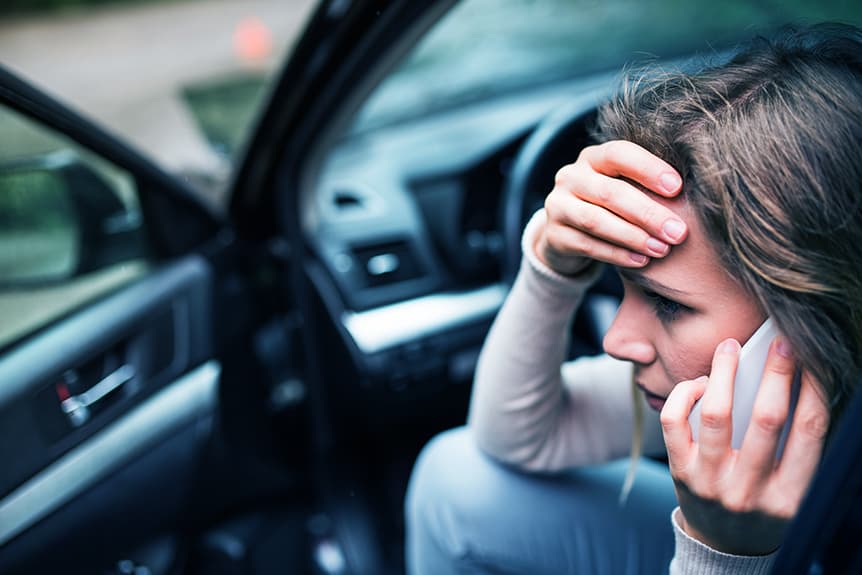5 Things to Do After Experiencing a Hit and Run Crash

Eleven percent of crashes that are reported to police are hit and run accidents. Often, the perpetrators get away. Jeff Bert, area commanding officer for the Los Angeles Police Department, expressed his sympathy for hit and run victims to the National Public Radio, “For families, for loved ones, for people who have lost the most precious thing in their life and then to have the department not be able to solve it, it must be maddening.”
To avoid repercussions, motorists often try to avoid responsibility by leaving the scene and hiding from what they have done. If you are ever the victim of a hit and run accident, you can follow several best practices to increase your chances of getting justice.
We are here to make sure you know what to do in the event that you are injured in a hit and run car crash. The more informed you are, the higher the odds that you achieve the fairest possible outcome and get what is rightfully owed to you in monetary retributions.
What Is a Hit and Run Accident?
Car crashes are a lot like snowflakes: no two are perfectly the same. While any given accident can be due to inclement weather conditions, human error, traffic circumstances, or a combination of the three, all can result in injuries and financial repercussions.
Every accident also varies in significance, and as far as crashes are concerned, few are more consequential—or potentially life-altering—than hit and run events. Hit and run crashes are just like they sound. It’s when an accident occurs and the driver flees the scene instead of doing the right (and legal) thing, which would be sticking around to exchange information and make sure all parties involved are okay.
How Often Do Hit and Run Accidents Happen?
Hit and runs are more common than you might believe. According to the AAA Foundation for Traffic Safety, approximately one in 10 crashes reported to police involve drivers who left the scene. What’s more, an estimated 1,500 people are killed each year in hit and run incidents, and 14,914 have been killed just between 1994 and 2003.
Hit and run events are often responsible for pedestrian deaths as well. In 2015, roughly 20 percent of individuals killed while walking or running on road surfaces were by motorists who fled in the immediate aftermath.
Officer Bert noted that hit and run crashes can be difficult to solve because there’s often little evidence to work with—a reality that can be devastating for the families of people who were killed or severely injured.
What Are the Penalties for a Hit and Run?
In an attempt to crack down on this problem and help minimize the incidences of the guilty driver leaving the scene before police arrive, hefty penalties are being put in place. In many areas, the penalty for a hit and run conviction causing death or serious injury is a felony punishable by imprisonment and/or a fine.
Imprisonment can be anywhere from five to 20 years, and the fine rangers $1,000–$10,000. The driver may also end up with a revocation of their license so that they will no longer present a threat to others on the road in the future.
5 Steps to Take If You Are the Victim of a Hit and Run Automobile Accident
If you or a loved one is the victim of a hit and run, here are five things you can do to get justice.
1. Capture as Much Information From the Hit and Run Driver as Possible
Fleeing drivers will try to make for a quick getaway, but if your car is struck, take mental or (ideally) written note of anything and everything that’s identifiable, such as the make and model of the car, the license plate, the vehicle’s color or anything else that is distinguishing. You’ll also want to determine the direction the motorist went in.
Each of these things can help the police track down the perpetrator and make it that much more likely you will receive any payment due to you—and that they will receive an appropriate punishment for their crime.
2. Call the Police to the Scene of the Hit and Run
Traffic enforcement should always be informed after a crash, but it’s particularly important when there’s been a hit and run. The police are better equipped with the resources that can help track down the person responsible and recover from your losses—whether only the car was affected or the incident also resulted in injury. If you do think you’ve been injured, you will also be able to request medical assistance at that time.
Keep in mind that you should report any information you have within the first 24 hours after the accident occurs, if possible. If you don’t report the hit and run to the police, you can be considered “at fault” by your insurer, which could impact your car insurance premium. Promptly notifying the proper authorities will make sure you are not at fault or responsible for damages.
3. Assess Your Medical Condition
Make sure to immediately assess any injuries that result from the accident and get proper medical care. Also remember that your injuries may take a day, week, or several weeks to materialize. Thus, depending on the severity of your injuries, get in touch with a doctor immediately. Or, at the very least, have your physician or primary care provider on standby so you can inform him or her about your symptoms as they crop up.
Your primary care provider should be able to determine if the injury resulted from the crash. For example, whiplash is a common car accident injury that often doesn’t present itself until later on. Other common car crash injuries include:
- Broken bones or herniated discs
- Whiplash
- Internal bleeding
- Head, knee, or chest injuries
- Psychological injuries that affect mental health, such as PTSD
4. Look for a Witnesses of the Hit and Run
Depending on the time of day that the crash occurred, you may be able to rely on witnesses who observed what happened. Firsthand accounts can be indispensable assets both for police and personal injury attorneys (who you may want to consider consulting with to see if you can be compensated for any potential medical bills that may incur).
Eyewitnesses can back up your story and help remember identifying details when you are too shaken up to fully process everything soon after it’s happened. A jarring event can make memory a bit fuzzy to those who were directly involved. A third party is sometimes the best option to get stories straight. When you do find a witness, be sure to write down their contact info so police and insurance can reach out as needed.
5. Check Your Insurance Policy
Of course, the insurer that covers your vehicle should be informed of what occurred, as the policy you have can also help defray some of the costs associated with the hit and run. Many states require motorists to carry uninsured motorist (UM) auto insurance—which, as the name suggests, pays for repairs and medical services even if those at fault don’t have insurance. The problem is that not all states require this type of policy. Furthermore, in some states, UM insurance doesn’t include hit and run events.
Where to Turn If You Think You Need More Help Than a Checklist
Hit and run cases can often be solved when there’s enough information to go off of—however, the process can cost you. Fortunately, there are organizations that get people just like you the resources they need for things like hiring an attorney when they might be short on cash. Don’t go through the process alone if you want the best chance at optimal results—turn to someone that can truly help.
To learn more, take advantage of this FREE download. And remember, you can never be “too” prepared—only under-prepared, which can have unfavorable consequences. We want to make sure that never happens. You don’t need extra things to worry about. Let us remove some of the stress from your life!



